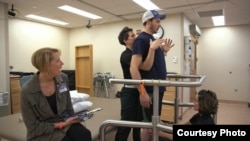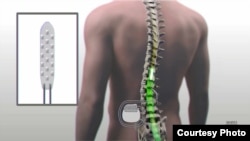Doctors have used an electrical stimulation technique that allowed a paralyzed man to move his legs, stand and “make steplike motions.”
Four years ago, a snowmobile accident left Jared Chinnock, in his 20s, of Wisconsin, paralyzed from the mid-torso down.
"I just thought I got the wind knocked out of me and needed to catch my breath and realized I couldn't get up," he told KARE television. "I was just pretty much set in my ways of I'm going to be in my wheelchair the rest of my life and I was all right with it."
But a new technique offers Chinnock some hope.
Doctors at the Mayo Clinic and UCLA found that physical therapy combined with electrical stimulation may one day allow some paralyzed people to “regain control over previously paralyzed movements.”
"We're really excited, because our results went beyond our expectations," says neurosurgeon Kendall Lee, principal investigator and director of Mayo Clinic's Neural Engineering Laboratory. "These are initial findings, but the patient is continuing to make progress."
To start the study, Chinnock did 22 weeks of physical therapy to prepare his muscles to move. He was regularly tested during that time to see changes and discovered it led them to characterize his injury as “discomplete,” meaning “dormant connections across his injury may remain.
After the physical therapy, surgeons implanted an electrode near the injured part of Chinnock’s spinal cord. The electrode is connected to a computer-controlled instrument under the skin on his abdomen.
The device senses thoughts of leg movement and sends electrical current to the spinal cord allowing Chinnock to move.
After a recovery period, Chinnock resumed physical therapy with the electric stimulation. Within two weeks, he was able to “control his muscles while lying on his side, resulting in leg movements,” make steplike motions while on his side and while standing with some support. He was also able to stand with some support.
"This has really set the tone for our post-surgical rehabilitation - trying to use that function the patient recovered to drive even more return of abilities," says Kristin Zhao, Ph.D., co-principal investigator and director of Mayo Clinic's Assistive and Restorative Technology Laboratory.
The results show that others with “discomplete” spinal cord injuries may benefit from the same kind of therapy, though researchers say more study needs to be done.
"While these are early results, it speaks to how Mayo Clinic researchers relentlessly pursue discoveries and innovative solutions that address the unmet needs of patients," says Gregory Gores, M.D., executive dean of research at Mayo Clinic. "These teams highlight Mayo Clinic's unique culture of collaboration, which brings together scientists and physician experts who work side by side to accelerate scientific discoveries into critical advances for patient care."
Though Chinnock could not feel his legs moving, he is optimistic.
"Hopefully maybe walking again someday, if not very far at least a little ways," he told KARE.
The study appears Tuesday in Mayo Clinic Proceedings.









